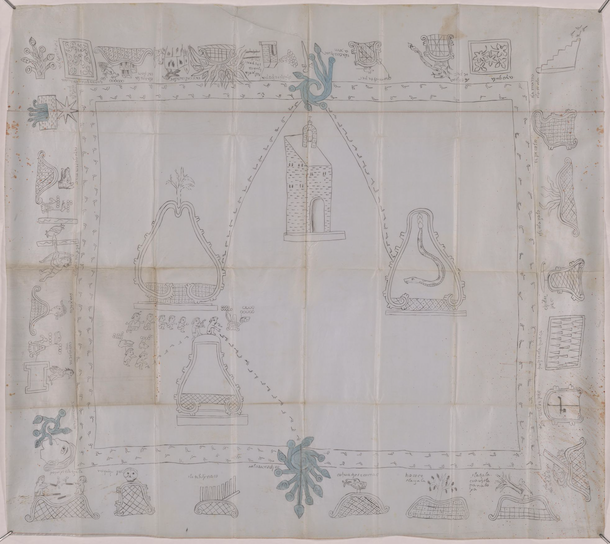Largest Collection of Colonial Latin American Art in Us Allapattah
The Mesoamerican maps in Princeton University Library (PUL)'s Special Collections can literally fill a room with pictorial imagery of baptisms, churches, and found life alongside text ranging from Nahuetl and Yucatec, to Spanish and Latin. The Library's largest map spans over eight feet tall and 6 feet wide.
While the detailed imagery portrayed in these Mesoamerican maps may non always tell the viewer how to navigate from betoken a to b, they tell a more compelling story, one of colonial transformation and indigenous resilience.

This tardily 18th to early 19th-century map of San Pedro Ixcatlan, in northern Oaxaca, Mexico, depicts the baptism of the indigenous lord don Juan de Mendoza in 1521. Princeton Mesoamerican Manuscript Collection.
This spring, students in the form, "Reading the Landscapes of Colonial Latin America," taught past Noa Corcoran-Tadd, associate research scholar and lecturer in Latin American studies, examined the Library's Mesoamerican manuscripts collection to gain insight into the dramatic influence of Castilian colonialism of the Americas.
Equally an exercise in chief inquiry, Corcoran-Tadd asked students to select a map from the drove to annotate and clarify. "I wanted to give students a chance to grapple with a single object," said Corcoran-Tadd. "The project was deliberately hard, given that most items use securely unfamiliar conventions and take however to be thoroughly studied. The idea was to familiarize students with the corpus of maps, and requite them tools and basic techniques used by historians to help them make sense of the items."
Given the virtual nature of the semester, Corcoran-Tadd worked with Gabriel Swift, librarian for academic programs, to select well-nigh a dozen maps for digitization, including "lienzos," a specific type of indigenous map portraying community lands and histories, too every bit land grants, which relate to the possession and transfer of land.
"Lienzos have deep roots in pre-hispanic Mexico and embody the tensions and paradoxes of the colonial period," said Corcoran-Tadd, "while examining land transfer through land grants is primal for a class looking at the workings of early colonialism and capitalism on the ground. These maps aren't just representations of the landscape, simply media through which the land is contested."
Co-ordinate to Swift, the Mesoamerican maps may be the largest objects in Special Collections. "If we hadn't digitized these," said Swift, "the physicality would have limited how many times nosotros brought them to a grade equally it can take four people to bring them out of storage."
These newly digitized maps may now be accessed by researchers across the world. "It really is a step forward," said Swift. The images are compliant with the image international interoperability framework (IIIF), which allows institutions such as museums and libraries to share images through URLs, rather than migrating large files.
Students in Corcoran-Tadd'southward class accessed the high-resolution images through Mirador, an paradigm viewer that allows users to zoom in and comment straight onto the files.
John White, a first-twelvemonth graduate educatee in art & archeology, examined his selected map, the Lienzo de San Pedro de Ixcatlan, as if it were a painting with simultaneous, unfolding narratives. "There is no pinnacle or lesser to the map. Each edge has images along the bottom," said White. "If we examine the diverse orientations, and the different sections i at a time -- moving slowly through the world of the map to take in the private scenes -- we sympathize them as moments in fourth dimension."
While many courses often involve lectures, reading, and writing, White said he appreciated that this course offered an exploratory style of learning and activated his brain in a dissimilar way.

Gawon Jo '23 examined the Lienzo Córdova-Castellanos, 20th-century tracing from 16th-century original, with text in Zapotec. Princeton Mesoamerican Manuscripts drove.
Gawon Jo, a sophomore concentrating in comparative literature, said that the form fabricated her question her previous assumptions, from mapping conventions to the history of agronomical practices.
"These maps don't await like Western or even Asian conceptions of mapping," said Jo. "They tend to define social relationships, and the relation between places and people, rather than a geographical sense," said Jo.
Corcoran-Tadd noted that the provenance of PUL's collection is unique, as it resulted primarily from the collecting pursuits of only ii men: William Gates (1863-1940) and Robert Garrett (1875-1961). Garrett, a Princeton alumnus and collector, bought the all-encompassing collection congenital by Gates, a Mayan scholar, and contributed his ain acquisitions over several decades, edifice one of the most prominent Mesoamerican manuscript collections in America. Garrett donated the collection to Princeton in 1947.
Researchers may find more than information about PUL'due south Mesoamerican Manuscripts collection hither.
Related story: PUL leads the Ivy League in Latin American Ethnic languages materials
Published April 23, 2021
Written by Emily Judd, Publicity Manager
Media contact:Barbara Valenza, Director, Library Communications
whiteheadprucestras.blogspot.com
Source: https://library.princeton.edu/news/general/2021-04-22/virtual-teaching-collections-%E2%80%98reading-landscapes-colonial-latin-america%E2%80%99
0 Response to "Largest Collection of Colonial Latin American Art in Us Allapattah"
Publicar un comentario